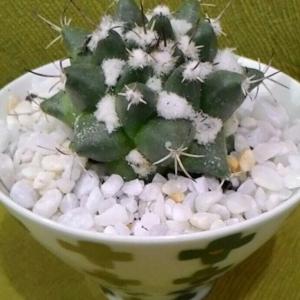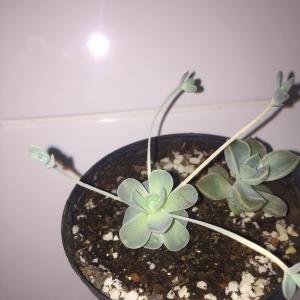文章
Dummer. ゛☀
2017年09月17日

Several fungal diseases attack lawn grasses. Following is a short description of the most common diseases to help you sort out which one may be causing your problem. The diseases have been categorized as patches (cause dead spots or patches in the lawn), rings (cause rings of dead or affected grass), or leaf blight (affect individual blades of grass, often over a wide area and no distinct patch or ring pattern may be noticeable). Since most grass diseases affect leaves, patches and rings describe certain diseases in more advanced stages of development.
Result in Dead Spots or Patches
BROWN PATCH (Rhizoctonia solani) Round patches of turf up to several feet in diameter appear watersoaked and eventually turn brown. Dark gray smoke ring is sometimes visible on lower mowed turf.
DOLLAR SPOT (Moellerodiscus spp. & Lanzia spp. or Sclerotinia homeocarpa) Rounded, straw-colored, slightly sunken patches up to 2 inches in diameter on bentgrass greens, 4–6 inches in diameter on other lawns. Spots have a reddish margin and expand until they girdle the leaf blade. Cottony mycelium may be evident in the morning growing over dead tissue.
RED THREAD (Laetisaria fuciformis) Pinkish patches from 3 to 15 inches in diameter develop during rainy weather. The grass in the patches is pink and dead and contains coral-red masses of mycelium. The disease is more common in fescues and grows best from 60 to 70 degrees F.
SNOW MOLD (Gerlachia nivalis and Typhula spp.) Grayish white patches up to 3 feet in diameter. Grass blades are collapsed and matted. Several different fungi are responsible for snow mold disease. Dead areas appear in the turf after the snow has melted.
PYTHIUM (Pythium spp.) Rounded sunken patches up to 1 foot in diameter. Leaves appear water-soaked and shiny at first, turning tan when dry. White mycelium grows over all leaf tissue, not just dead tissue as in dollar spot.
Result in a Ring in the Lawn
FAIRY RING (Marasmius oreades and others) Dark green ring with lighter green center, 2 ft to 100 ft in diameter. A mycelium starts in one spot and spreads in all directions. At certain times of the year, the fruiting bodies, mushrooms, may develop near the outer borders of the year’s growth of mycelium. The grass within the ring may appear to be healthy but later may collapse and die.
NECROTIC RING SPOT (Leptosphaeria korrae) 1–3 patches of red or purple leaves that bleach with water stress. Many patches grow greater than 12 inches in diameter with weeds or resistant grasses forming frog-eyes in the center of the ring.
SUMMER PATCH (Magnaporthe poae) Small tan or straw-colored spots appear on the leaves in early summer. These spots enlarge and coalesce until large areas of the lawn are killed. This disease is active only during the warmest part of the summer.
Affects Scattered Leaves
POWDERY MILDEW (Erysiphe graminis) Powdery mildew appears as dirty spots or blotches on the leaf sheaths, varying in color from light gray to brownish. It is especially prone to develop in wet weather and on poorly drained lawns. The infection spreads by the numerous white spores, which form on infected leaves.
LEAF SPOTS (also called Melting out, various organisms) Many grasses are affected by leaf spot diseases. General symptoms include tan or strawcolored spots on leaves usually bordered by a darker color. Black spore-producing structures may be seen in the center of the spots of some diseases.
RUST (Puccinia graminis var. agrostis) The disease appears as small, reddish spots on the leaves. Merion bluegrass, a special strain of Kentucky bluegrass, is very susceptible to this disease.
ANTHRACNOSE (Colletotrichum graminicola). This disease is common on creeping bentgrass and annual bluegrass. The fungus causes individual grass blades and/or plants to yellow and die when it invades crown and root tissue. Black, hairy, and spiny fruiting bodies are abundantly produced on dead tissue but may also be seen on green leaves as well.

Result in Dead Spots or Patches
BROWN PATCH (Rhizoctonia solani) Round patches of turf up to several feet in diameter appear watersoaked and eventually turn brown. Dark gray smoke ring is sometimes visible on lower mowed turf.
DOLLAR SPOT (Moellerodiscus spp. & Lanzia spp. or Sclerotinia homeocarpa) Rounded, straw-colored, slightly sunken patches up to 2 inches in diameter on bentgrass greens, 4–6 inches in diameter on other lawns. Spots have a reddish margin and expand until they girdle the leaf blade. Cottony mycelium may be evident in the morning growing over dead tissue.

RED THREAD (Laetisaria fuciformis) Pinkish patches from 3 to 15 inches in diameter develop during rainy weather. The grass in the patches is pink and dead and contains coral-red masses of mycelium. The disease is more common in fescues and grows best from 60 to 70 degrees F.
SNOW MOLD (Gerlachia nivalis and Typhula spp.) Grayish white patches up to 3 feet in diameter. Grass blades are collapsed and matted. Several different fungi are responsible for snow mold disease. Dead areas appear in the turf after the snow has melted.
PYTHIUM (Pythium spp.) Rounded sunken patches up to 1 foot in diameter. Leaves appear water-soaked and shiny at first, turning tan when dry. White mycelium grows over all leaf tissue, not just dead tissue as in dollar spot.

Result in a Ring in the Lawn
FAIRY RING (Marasmius oreades and others) Dark green ring with lighter green center, 2 ft to 100 ft in diameter. A mycelium starts in one spot and spreads in all directions. At certain times of the year, the fruiting bodies, mushrooms, may develop near the outer borders of the year’s growth of mycelium. The grass within the ring may appear to be healthy but later may collapse and die.
NECROTIC RING SPOT (Leptosphaeria korrae) 1–3 patches of red or purple leaves that bleach with water stress. Many patches grow greater than 12 inches in diameter with weeds or resistant grasses forming frog-eyes in the center of the ring.

SUMMER PATCH (Magnaporthe poae) Small tan or straw-colored spots appear on the leaves in early summer. These spots enlarge and coalesce until large areas of the lawn are killed. This disease is active only during the warmest part of the summer.
Affects Scattered Leaves
POWDERY MILDEW (Erysiphe graminis) Powdery mildew appears as dirty spots or blotches on the leaf sheaths, varying in color from light gray to brownish. It is especially prone to develop in wet weather and on poorly drained lawns. The infection spreads by the numerous white spores, which form on infected leaves.

LEAF SPOTS (also called Melting out, various organisms) Many grasses are affected by leaf spot diseases. General symptoms include tan or strawcolored spots on leaves usually bordered by a darker color. Black spore-producing structures may be seen in the center of the spots of some diseases.
RUST (Puccinia graminis var. agrostis) The disease appears as small, reddish spots on the leaves. Merion bluegrass, a special strain of Kentucky bluegrass, is very susceptible to this disease.

ANTHRACNOSE (Colletotrichum graminicola). This disease is common on creeping bentgrass and annual bluegrass. The fungus causes individual grass blades and/or plants to yellow and die when it invades crown and root tissue. Black, hairy, and spiny fruiting bodies are abundantly produced on dead tissue but may also be seen on green leaves as well.
0
0
求助
shirly mei
2017年09月16日

please help, my aloe is browning and the leaves are becoming flat. is it too much sun light?
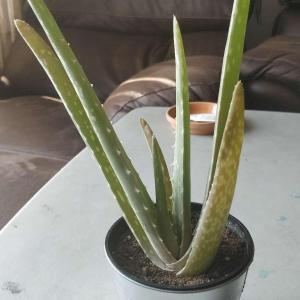


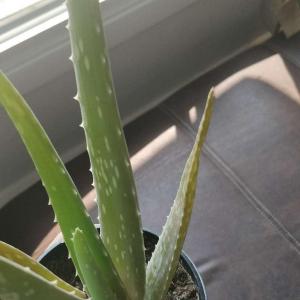




1
0
Dianna Goade:yes to much sun, put it in the shade and it will grow like crazy. thats how it grows in texas
shirly mei:@sunnyzou I haven't watered a ton tho. I water once the soil is dry.
sunnyzou:too much water
求助
Katrina
2017年09月16日

My Senecio Vitalis (Blue Chalk Fingers) plant keeps having limbs shrivel and die! Please help! I keep it out of direct sunlight and only water it every 3 to 4 days depending on need. I just separated the roots of the two plants and repoted a week ago.
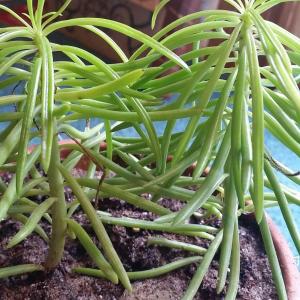

0
0
sunnyzou:maybe you hurt the roots when you repotting. no direct sunlight until they recovered growth.
Ueca:I know this sounds somewhat counter-intuitive, but try giving it a bit more sunlight.
softwpeach
2017年09月15日

could you help me to discover what type of succulents is this?? Please help me


1
0
文章
Dummer. ゛☀
2017年09月15日

The mealybug predator, better known as Cryptolaemus montrouzieri, was originally brought to America from Australia over 100 years ago by Albert Koebele, an early champion of biological controls. Used to help control an outbreak of the the citrus mealybug — mission accomplished! — these small lady beetles are deadly as adults and larvae to aphids and soft scale insects as well as mealybugs.
Shop our large selection of biological controls, including mealybug predators, at Planet Natural. One vial — 100 “crypts” — treats up to 50 plants and costs $84.95 with FedEx Overnight shipping included!
Mostly black with a tan front, the adult Cryptolaemus searches out the waxy, sometimes cotton-like egg cases of its prey. It then lays its own eggs nearby. The larvae emerge within five days and begin to feed on the eggs as well as the young crawler stage and the pest’s honeydew . After three larval stages, the mealy bug larvae enter the pupal stage before becoming egg-laying adults. The process takes approximately three weeks. Adult females will lay some 400 eggs over their two month life span.
While this predatory beetle thrives on high mealybug populations, they are best released in early spring when the first pests are observed. The predatory beetles are most active at 70°F or higher and should be released at a rate of 0.5 per square foot of planted area, or 2-5 beetles per infested plant. In orchards, release 1,000-2,000 adult beetles per acre of mature fruit trees.
HOW TO RELEASE:
Adult beetles are shipped in vials mixed with paper strips to provide protection.
Water the area to be protected and gently shake the contents evenly over, or near, the pest problem.
Do NOT release during the sunny part of the day, but rather wait until evening or early morning.
Repeat as necessary, usually once or twice per year.

Shop our large selection of biological controls, including mealybug predators, at Planet Natural. One vial — 100 “crypts” — treats up to 50 plants and costs $84.95 with FedEx Overnight shipping included!
Mostly black with a tan front, the adult Cryptolaemus searches out the waxy, sometimes cotton-like egg cases of its prey. It then lays its own eggs nearby. The larvae emerge within five days and begin to feed on the eggs as well as the young crawler stage and the pest’s honeydew . After three larval stages, the mealy bug larvae enter the pupal stage before becoming egg-laying adults. The process takes approximately three weeks. Adult females will lay some 400 eggs over their two month life span.

While this predatory beetle thrives on high mealybug populations, they are best released in early spring when the first pests are observed. The predatory beetles are most active at 70°F or higher and should be released at a rate of 0.5 per square foot of planted area, or 2-5 beetles per infested plant. In orchards, release 1,000-2,000 adult beetles per acre of mature fruit trees.

HOW TO RELEASE:
Adult beetles are shipped in vials mixed with paper strips to provide protection.
Water the area to be protected and gently shake the contents evenly over, or near, the pest problem.
Do NOT release during the sunny part of the day, but rather wait until evening or early morning.
Repeat as necessary, usually once or twice per year.
0
0
文章
Dummer. ゛☀
2017年09月14日

Homemade remedies are a longstanding tradition among organic gardeners, who have had to be creative in finding ways to battle insects and diseases without the help of synthetic chemicals. In the case of fighting aphids, two homemade sprays have proven very effective in controlling aphid infestations. Organic gardeners have been using tomato leaf spray or garlic oil spray to battle aphids for generations.
While knowing how to make and use them is important, it's equally important to understand why they work.
Tomato Leaf Spray
Tomato plants, as members of the nightshade family, contain toxic compounds called alkaloids in their leaves. When the leaves of tomato plants are chopped, they release their alkaloids. When the alkaloids are suspended and diluted with water, they make an easy to use spray that is toxic to aphids, but still safe around plants and humans.
How to Make Tomato Leaf Spray
Simply chop one or two cups of tomato leaves and soak them in two cups of water. Let it steep overnight. Strain out the leaves using cheesecloth or a fine strainer; then add another one to two cups of water to the liquid and add it to a spray bottle.
Applying Tomato Leaf Spray
Use the mixture by spraying the stems and foliage of the infested plant, paying particular attention to the undersides of leaves since that is where aphids most commonly congregate.
One word of caution, while this spray is very safe for humans, some people are allergic to members of the nightshade family. If you are one of them, use care in making and applying this spray.
Garlic Oil Spray
Organic gardeners have long relied on garlic as part of their pest-fighting arsenal. Garlic contains sulfur, which, besides being toxic to pests, is also an antibacterial and antifungal agent.
The dish soap in this mixture also breaks down the bodies of soft-bodied pests, such as aphids.
How to Make Garlic Oil Spray
To make garlic oil spray, mince or finely chop three to four cloves of garlic, and add them to two teaspoons of mineral oil. Let this mixture sit for 24 hours. Strain out the garlic pieces, and add the remaining liquid to one pint of water. Add one teaspoon of liquid dish soap. This mixture can be stored and diluted as needed.
Applying Garlic Oil Spray
Before using this spray test it by spraying an inconspicuous part of the plant. If there are no signs of yellowing or other leaf damage after a day or two, it is safe to use. If there is leaf damage, dilute the mixture with more water and try the test again. Once you have determined that it won't harm your plant, spray the entire plant, paying particular attention to the undersides of leaves.
A word of caution about this spray, garlic oil is a non-selective insecticide. It will kill beneficial insects (such as ladybugs, who are natural predators of aphids) just as easily as it kills the bad guys. It's best to keep as many beneficial insects around as possible. This spray should only be used if you haven't seen any beneficial bugs in your garden.
The tomato leaf recipe, above, won't harm beneficial bugs, so you should use that if you're lucky enough to have some in your garden.

While knowing how to make and use them is important, it's equally important to understand why they work.
Tomato Leaf Spray
Tomato plants, as members of the nightshade family, contain toxic compounds called alkaloids in their leaves. When the leaves of tomato plants are chopped, they release their alkaloids. When the alkaloids are suspended and diluted with water, they make an easy to use spray that is toxic to aphids, but still safe around plants and humans.

How to Make Tomato Leaf Spray
Simply chop one or two cups of tomato leaves and soak them in two cups of water. Let it steep overnight. Strain out the leaves using cheesecloth or a fine strainer; then add another one to two cups of water to the liquid and add it to a spray bottle.

Applying Tomato Leaf Spray
Use the mixture by spraying the stems and foliage of the infested plant, paying particular attention to the undersides of leaves since that is where aphids most commonly congregate.
One word of caution, while this spray is very safe for humans, some people are allergic to members of the nightshade family. If you are one of them, use care in making and applying this spray.

Garlic Oil Spray
Organic gardeners have long relied on garlic as part of their pest-fighting arsenal. Garlic contains sulfur, which, besides being toxic to pests, is also an antibacterial and antifungal agent.
The dish soap in this mixture also breaks down the bodies of soft-bodied pests, such as aphids.

How to Make Garlic Oil Spray
To make garlic oil spray, mince or finely chop three to four cloves of garlic, and add them to two teaspoons of mineral oil. Let this mixture sit for 24 hours. Strain out the garlic pieces, and add the remaining liquid to one pint of water. Add one teaspoon of liquid dish soap. This mixture can be stored and diluted as needed.

Applying Garlic Oil Spray
Before using this spray test it by spraying an inconspicuous part of the plant. If there are no signs of yellowing or other leaf damage after a day or two, it is safe to use. If there is leaf damage, dilute the mixture with more water and try the test again. Once you have determined that it won't harm your plant, spray the entire plant, paying particular attention to the undersides of leaves.

A word of caution about this spray, garlic oil is a non-selective insecticide. It will kill beneficial insects (such as ladybugs, who are natural predators of aphids) just as easily as it kills the bad guys. It's best to keep as many beneficial insects around as possible. This spray should only be used if you haven't seen any beneficial bugs in your garden.
The tomato leaf recipe, above, won't harm beneficial bugs, so you should use that if you're lucky enough to have some in your garden.
0
0
文章
Dummer. ゛☀
2017年09月14日

This introduction to organic ant control in the yard will answer three questions:
Do these insects truly cause damage in your yard?
Which herbs have traditionally been used to repel them?
Which products can help you in your organic ant control efforts?
Is It Really Necessary?
If you mention in certain circles that you practice ant control in the yard, you're likely to have some smart aleck pipe up and rant, "That's not really necessary, because these insects don't cause much damage to plants, so just leave them alone." But what your Mr. Know-It-All isn't recognizing in his rant is that, indirectly, ants can cause significant damage to plants.
Ants have a sweet tooth for honeydew, a substance secreted by insect pests such as aphids, scale and whitefly. Not content to take a "hunter-gatherer" approach to supplying themselves with honeydew, ants act as "farmers," herding around the insect pests that secrete the honeydew. The herders protect these insect pests from predatory insects that would, otherwise, kill them.
Ant control, then, can be regarded as a measure to take against insect pests such aphids, scale and whitefly. Incidentally, as if the direct damage caused by these herded insect pests weren't sufficiently troubling to convince you that ant control is a legitimate concern, consider this: sooty mold, a fungus that often coats honeydew-stained plants, can damage a plant by depriving it of sufficient sunlight. Oh, and sooty mold turns ornamental plants into eyesores, too, by the way.
Now that you understand when and why it's necessary to take action, let's consider a few organic methods used to tackle the problem.
Note also that, in addition to the organic tips discussed below, successes in organic ant control have been reported using everything from parasitic wasps to talcum powder.
Getting Rid of Ants Naturally Through Companion Planting
As gardeners, I think we're enamored with the idea that the solution to one plant's problem may well lie in another plant.
Indeed, companion planting has helped gardeners deal effectively -- and organically -- with pests for centuries. There are even companion-planting solutions for ant control. Specifically, the fragrance of certain herbs has been thought to repel certain insects, including ants.
Before I cite examples of plants used traditionally for organic ant control, however, let me issue a disclaimer. One gardener may swear that such and such an herb discourages ants; but that doesn't much help another gardener (living, perhaps, in a different region) who tries the same herb but fails to enjoy the same results. Remember that a given herb may not repel all types of ants. If you wish to try companion planting for organic ant control, be ready to experiment: Don't take anything as "the Gospel truth," or you may suffer disappointment.
Besides, the nice thing about companion planting is that, even if it fails, all you're "stuck" with (besides the insects you're fighting, that is) are some additional plants -- plants which you may end up liking so much for their ornamental value, etc. that you decide they're now must-haves for your yard (so you haven't wasted any money, at least).
Examples of Herbs Used in Organic Ant Control
Click on the links below to determine if lavender, sage, catnip or tansy might be plants you'd be interested in trying for organic ant control:
Lavender
Sage
Catnip
Tansy
In experimenting with herbs for organic ant control, remember that you have some leeway in terms of exactly how you use the plants. This is an important consideration when you realize that tansy, for example, can be among the worst invasive plants. So note carefully that you don't necessarily have to plant the herbs for organic ant control around your specimen plants.
Instead, you can harvest the leaves from the herbs (grown elsewhere), then simply strew the leaves around a specimen plant. If you suspect a plant to be overly aggressive, plant it in a raised bed, where you have more control over it. Remember, too, that you would be targeting only specimen plants susceptible to aphids, scale and whitefly when employing this ant control method.
Organic Ant Control Products
"But," perhaps you object, "I don't have time to experiment with traditional methods of ant control.
Is there an organic product that I can buy in stores or on the Web?" Fortunately, for the committed modernist, yes, there are organic products sold for getting rid of ants.
One such ant control product is the Tree Tanglefoot Pest Barrier, an organic paste composed primarily of sticky substances (waxes and resins) that act as a sort of "fly paper" for ants. Another is Orange Guard, which functions as both a repellent and an insecticide for getting rid of ants. Its active ingredient (d-Limonene) is organic: orange peel extract. Eco Exempt IC-2 is another organic insecticide for ant control, being composed of mineral, wintergreen and rosemary oils.
Final Thought on Getting Rid of Ants in the Yard
In closing, let's return to my initial question of whether it's necessary to get rid of ants in the yard, at all. As I stated above, controlling aphids, scale and whitefly entails, in part, controlling ants. But the corollary of this conclusion (vis-a-vis the health of your specimen plants, at least) is that if you do not have a problem with aphids, scale or whitefly, then you may not have to worry about getting rid of ants, either: many ants are, in themselves, harmless.
So don't overdo it! In defense of ants, your Mr. Know-It-All would have been correct to point out that ants do prey on certain insect pests. Ant control can be counterproductive when practiced blindly.
Do these insects truly cause damage in your yard?
Which herbs have traditionally been used to repel them?
Which products can help you in your organic ant control efforts?

Is It Really Necessary?
If you mention in certain circles that you practice ant control in the yard, you're likely to have some smart aleck pipe up and rant, "That's not really necessary, because these insects don't cause much damage to plants, so just leave them alone." But what your Mr. Know-It-All isn't recognizing in his rant is that, indirectly, ants can cause significant damage to plants.
Ants have a sweet tooth for honeydew, a substance secreted by insect pests such as aphids, scale and whitefly. Not content to take a "hunter-gatherer" approach to supplying themselves with honeydew, ants act as "farmers," herding around the insect pests that secrete the honeydew. The herders protect these insect pests from predatory insects that would, otherwise, kill them.

Ant control, then, can be regarded as a measure to take against insect pests such aphids, scale and whitefly. Incidentally, as if the direct damage caused by these herded insect pests weren't sufficiently troubling to convince you that ant control is a legitimate concern, consider this: sooty mold, a fungus that often coats honeydew-stained plants, can damage a plant by depriving it of sufficient sunlight. Oh, and sooty mold turns ornamental plants into eyesores, too, by the way.
Now that you understand when and why it's necessary to take action, let's consider a few organic methods used to tackle the problem.
Note also that, in addition to the organic tips discussed below, successes in organic ant control have been reported using everything from parasitic wasps to talcum powder.

Getting Rid of Ants Naturally Through Companion Planting
As gardeners, I think we're enamored with the idea that the solution to one plant's problem may well lie in another plant.
Indeed, companion planting has helped gardeners deal effectively -- and organically -- with pests for centuries. There are even companion-planting solutions for ant control. Specifically, the fragrance of certain herbs has been thought to repel certain insects, including ants.
Before I cite examples of plants used traditionally for organic ant control, however, let me issue a disclaimer. One gardener may swear that such and such an herb discourages ants; but that doesn't much help another gardener (living, perhaps, in a different region) who tries the same herb but fails to enjoy the same results. Remember that a given herb may not repel all types of ants. If you wish to try companion planting for organic ant control, be ready to experiment: Don't take anything as "the Gospel truth," or you may suffer disappointment.

Besides, the nice thing about companion planting is that, even if it fails, all you're "stuck" with (besides the insects you're fighting, that is) are some additional plants -- plants which you may end up liking so much for their ornamental value, etc. that you decide they're now must-haves for your yard (so you haven't wasted any money, at least).
Examples of Herbs Used in Organic Ant Control
Click on the links below to determine if lavender, sage, catnip or tansy might be plants you'd be interested in trying for organic ant control:
Lavender
Sage
Catnip
Tansy
In experimenting with herbs for organic ant control, remember that you have some leeway in terms of exactly how you use the plants. This is an important consideration when you realize that tansy, for example, can be among the worst invasive plants. So note carefully that you don't necessarily have to plant the herbs for organic ant control around your specimen plants.

Instead, you can harvest the leaves from the herbs (grown elsewhere), then simply strew the leaves around a specimen plant. If you suspect a plant to be overly aggressive, plant it in a raised bed, where you have more control over it. Remember, too, that you would be targeting only specimen plants susceptible to aphids, scale and whitefly when employing this ant control method.
Organic Ant Control Products
"But," perhaps you object, "I don't have time to experiment with traditional methods of ant control.
Is there an organic product that I can buy in stores or on the Web?" Fortunately, for the committed modernist, yes, there are organic products sold for getting rid of ants.

One such ant control product is the Tree Tanglefoot Pest Barrier, an organic paste composed primarily of sticky substances (waxes and resins) that act as a sort of "fly paper" for ants. Another is Orange Guard, which functions as both a repellent and an insecticide for getting rid of ants. Its active ingredient (d-Limonene) is organic: orange peel extract. Eco Exempt IC-2 is another organic insecticide for ant control, being composed of mineral, wintergreen and rosemary oils.
Final Thought on Getting Rid of Ants in the Yard
In closing, let's return to my initial question of whether it's necessary to get rid of ants in the yard, at all. As I stated above, controlling aphids, scale and whitefly entails, in part, controlling ants. But the corollary of this conclusion (vis-a-vis the health of your specimen plants, at least) is that if you do not have a problem with aphids, scale or whitefly, then you may not have to worry about getting rid of ants, either: many ants are, in themselves, harmless.

So don't overdo it! In defense of ants, your Mr. Know-It-All would have been correct to point out that ants do prey on certain insect pests. Ant control can be counterproductive when practiced blindly.
0
0
求助
twunklink
2017年09月10日

can i have some help IDing these succulents and a (maybe) baby cactus in this pot i picked up? thanks!!
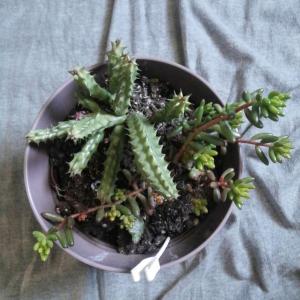
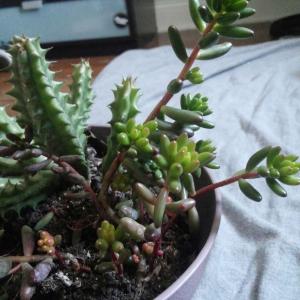
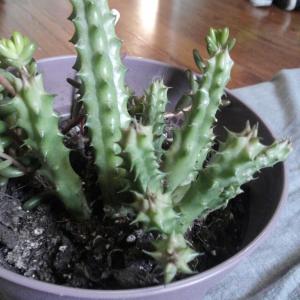
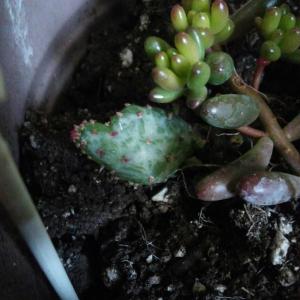




0
0
Ueca:Brown plant with stems is Sedum rubrotinctum.
Mohammed Othman AlDabadab
2017年09月09日

Anyone Know it Please
Good Day All
This plant look like Mushrooms
But i don't know what its
Anyone can help Please
Hope it's Not Poison One







Good Day All
This plant look like Mushrooms
But i don't know what its
Anyone can help Please
Hope it's Not Poison One







0
0
Succulentsister
2017年09月09日
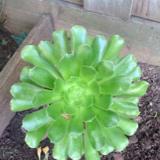
The babies are growing well on this aeonium Holochrysum do you have any tips for me to help them grow or when i take them off the big guy
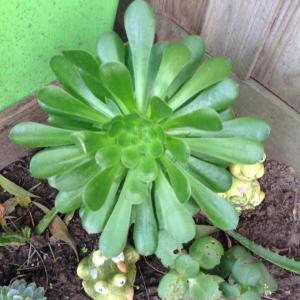
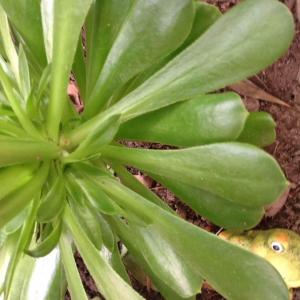


3
0
meriunkat:you'd need to use sharp scissors and let the cutting dry for at least two days before planting so it won't rot, but yeah wait and see when it grows stem
meriunkat:hmm I think it would be more safe to remove the babies when they have a stem😺
求助
Aelo
2017年09月09日

Can someone help identify this succulent? Some care tips too since im new. Thanks!


0
0
Aelo:@meriunkat Thank you
meriunkat:it seems to be a Perle Von Nurnberg
求助
oliviavael_27
2017年09月07日
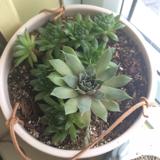
Help! Firstly i need help identifying this succulent, i have a feeling it is a type of echeveria. Secondly, i think its sick. The 'branches' have gone really limp, and the leaves at the bottom are dying off a lot quicker than i know is normal. I cant see any root rot, so please help any advice appreciated!! #help
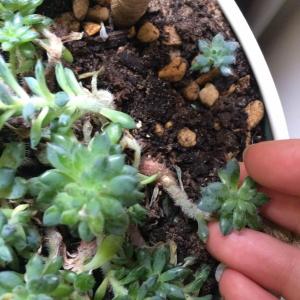
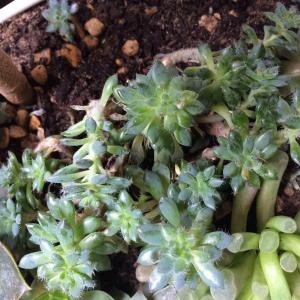


1
1
Ueca:It looks like Echeveria setosa var. minor. Succulents often discard leaves that are not catching enough sun.
求助
xisquare
2017年09月06日

Help! The leaves on my moonstone keeps dropping by itself, and I don't know what's causing it. I did notice the stem turning dry and brown, don't know if it's related. Last time I watered was about 5 days ago.


2
1
Ueca:Make sure you use a sharp, sterile blade to thoroughly remove all the blackened tissue. Dry the wound in an unlit location (~2 days for your plant) before planting.
meriunkat:you can use the fallen leaves to propagate as well
meriunkat:you should take it out and if the bottom is all brown the plant may be dying, you would have to cut off the brown part let it dry for a day before repoting..
meriunkat:how much sun light is it taking in?
meriunkat:what soil do you use?
显示更多



